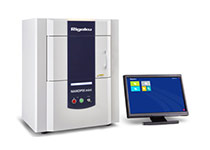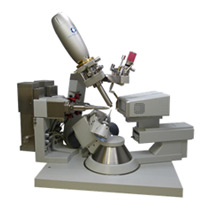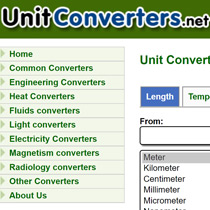| Non-destructive measurement of particle size and size distribution |
 |
| NANOPIX mini |
| Rigaku NANOPIX mini is the world's first benchtop small angle X-ray scattering (SAXS) system that is engineered to deliver automatic nanoparticle size distribution analysis for both quality control (QC) and research and development (R&D) applications. Nanoparticle size, size distribution, and particle shape are the key pieces of information obtained from SAXS. Samples may range from solutions, suspensions or slurries to solid plastics, rubbers or polymers.
For more > |
|
| Interested in publishing your work in The Bridge? |
 |
| Publish Your Work Here |
| The Bridge now welcomes manuscripts, communications, and papers that describe techniques and applications of all forms of X-ray fluorescence (XRF) and X-ray diffraction (XRD, including SAXS) that are of interest to fellow scientists in industry, academia, and government. Manuscripts, in PDF format, are only accepted with the understanding that they are not commercial in nature. Authors are responsible for all statements made in their work. If illustrations or other material in a manuscript have been published previously, the author is responsible for obtaining permission to republish. Please send copy to the editor at Rigaku.newsletter@Rigaku.com
|
|
| An upgradeable single crystal X-ray diffractometer for structural analysis of small molecule samples |
 |
| Synergy-i |
The XtaLAB Synergy-i single crystal X-ray diffractometer includes a high-flux, low maintenance microfocus sealed tube source, a high-precision 4-circle kappa goniometer and one of Rigaku's own Hybrid Photon Counting (HPC) X-ray detectors, the HyPix Bantam. Containing the latest microfocus source technology the XtaLAB Synergy-i can be upgraded to dual source (Cu/Mo) to address a wider range of research interests. For ease of use and high performance, the system is controlled by the fully-integrated, user-inspired CrysAlisPro software package, which is capable of collecting and processing data efficiently and accurately, so you achieve the best data possible.
For more > |
|
| Video of the Month |
 |
| The Secrets of Quantum Physics | Einstein's Nightmare |
The Secrets of Quantum Physics is a two-part British television series outlining the theories of quantum mechanics and quantum biology. This episode traces a path from the 1800s through the jazz age to the current era, highlighting insights into light which illuminated the true nature of reality, the conflicts with the ideas of Albert Einstein and recreating the test to resolve this conflict devised by John Bell.
Watch video > |
|
| Conferences and Workshops |
 |
Join Rigaku
at future meetings |
Rigaku will be sponsoring, attending or exhibiting at the following conferences and trade shows:
Pittcon 2018
Orlando, FL, USA
February 26 – March 1, 2018
Security Show 2018
Tokyo, Japan
March 7 – 9, 2018
ACS Spring 2018
New Orleans, LA, USA
March 18 – 22, 2018
See the complete list >
|
|
| Useful Link of the Month |
 |
| Unit Converters |
|
In human history, different units systems were developed and used in different regions and cultures. Now there is a global standard, the International System of Units (SI), which is a modern form of the metric system. Most countries have officially adopted the metric system (SI), except United States, Myanmar and Liberia. The official unit system in the United States is U.S customary units, which is very similar to the imperial units. The imperial units were mostly used in the British Commonwealth and the former British Empire. Both U.S customary units and the imperial units derive from earlier English units. For more >
|
|
| Planning to submit a grant? |
 |
| Rigaku is happy to assist |
| If you are planning on submitting an instrument grant proposal, Rigaku will be happy to assist you. We can help you determine the correct instrument and configuration best suited for your analytical needs.
Start the process >
|
|
| Rigaku's Materials Analysis eNewsletter, The Bridge |
 |
| Join us |
| Each month, Rigaku distributes two eNewsletters: The Bridge, which focuses on Materials Analysis, and Crystallography Times, which concentrates on X-ray crystallography.
Join us >
|
|
|
|
Welcome
This week Rigaku is exhibiting at The Pittsburgh Conference on Analytical Chemistry and Applied
Spectroscopy (Pittcon 2018, booths 2000 – 2002 at the Orange County Convention Center, Orlando, Florida. New at the show is the Rigaku NEX LS, which represents the next evolution of scanning multi-element process coatings analyzers for web or coil applications.

Portland Head Lighthouse (Cape Elizabeth, ME) and its surroundings (pictures by Kenichi Yaoita)
This month's issue contains three Rigaku Journal articles. The first describes a new method for quantitative phase analysis while the second
discusses the latest benchtop MiniFlex XRD with a
2D detector. The final article covers the 2017 Nobel Prize in Chemistry.
Application papers are also included for EDXRF, WDXRF, and single crystal X-ray diffraction (SCX). The
book review covers an expertly curated set of exemplary
pieces from 2016, culled by biologist/science writer Hope Jahren. Check out the news and papers sections at the bottom of the page for the latest developments in materials science.
R.C. Tisdale, Ph.D. – Editor
 |
|
Featured Rigaku Journal Article
The 2017 Nobel Prize in Chemistry
By Akihito Yamano, Rigaku Corporation
The 2017 Nobel Prize in Chemistry was awarded to Dr. Joachim Frank of Columbia University, Dr. Jacques Dubochet of Lausanne University and Dr. Richard Henderson of MRC Molecular Biology Institute for "developing cryo-electron microscopy for the high-resolution structure determination of biomolecules in solution".
Full article > |
 |
|
WDXRF Application Note
Ultra Low P, S, Cl Analysis in Liquids with a Benchtop WDXRF Spectrometer
Rigaku Corporation
Phosphorous, sulfur and chlorine are commonly analyzed elements in liquids such as petroleum products and organic solvents. For example, phosphorous is added to lubricating oils to prevent wear of gears under high pressure. Sulfur content in automotive fuel oils are regulated by the US environmental protection agency (EPA) and directives such as EURO VI to minimize air pollution due to automotive vehicles. Chlorine, contained for example in crude oil, is an unwanted element known for corroding oil processing installations and liquid transmission pipelines. For more > |
 |
|
WDXRF Application Note
Silicate Rock Analysis by Fusion Method
Rigaku Corporation
Geochemical data set for silicate rocks are essential for modern petrology. Concentrations of major and trace components in igneous rock sample provide many kinds of information about rock history such as eruption or solidification, magma evolution, magma genesis and source materials as well as petrographical classification. For more > |
 |
|
EDXRF Application Note
Mud Logging
Applied Rigaku Technologies
When drilling for crude oil and natural gas, rock
cuttings are brought to the surface by the drilling
mud for examination and characterization of the
rock strata. Mineralogy and elemental composition
are some of the tests that go into the lithology of
the rock layers, giving valuable information on the
formation being drilled for well logging and
positioning of the drill bit when geosteering. XRF gives elemental composition of the cuttings, an important part of the overall well logging system. To meet the industry needs, Applied Rigaku Technologies offers Energy Dispersive XRF (EDXRF) analyzer NEX QC+ QuantEZ for measuring elemental composition of various geological materials. For more > |
 |
|
Material Analysis in the News
News for February 2018
February 1, 2018. A research team from the Department of Energy's Lawrence Berkeley National Laboratory (Berkeley Lab) has found the first evidence that a shaking motion in the structure of an atomically thin (2-D) material possesses a naturally occurring circular rotation. This rotation could become the building block for a new form of information technology, and for the design of molecular-scale rotors to drive microscopic motors and machines.
February 4, 2018. A team of researchers at Osaka University in Japan, in collaboration with the Max Planck Institute for Polymer Research in Germany, has invented a polymer that is easy to manufacture and has excellent conversion efficiency of solar power to electricity. Plastic solar cells, based on blends of conducting organic polymers, are of interest for making lightweight and cheap solar cells.
February 8, 2018. Nanographenes are attracting wide interest from many researchers as a powerful candidate for the next generation of carbon materials due to their unique electric properties. A group of chemists of the JST-ERATO Itami Molecular Nanocarbon Project and the Institute of Transformative Bio-Molecules (ITbM) of Nagoya University has now developed a fast way to form nanographenes in a controlled fashion. This simple and powerful method for nanographene synthesis could help generate a range of novel optoelectronic materials, such as organic electroluminescent displays and solar cells.
February 9, 2018. Graphene and its nano-sized little sibling, nanographene, are well known for their remarkable photoelectronic properties. However, biomedical applications are hampered by the insolubility of the materials, especially in water. A Japanese team of scientists, led by Kenichiro Itami at Nagoya University, Japan, has now introduced while maintaining its photophysical properties.
February 16, 2018. Dr. Masato Watanabe has been included in Marquis Who's Who. A widely regarded materials scientist with more than 20 years of experience, Dr. Watanabe has been a chief research scientist with Research Institute for Electromagnetic Materials since 2014, having been a specially appointed research scientist since 2012. Prior to this, he worked as the managing director of MHW Informatics, Inc., from 2005 to 2007, and with Research Institute for Electric and Magnetic Material as a senior researcher from 2001 to 2004, and as a researcher from 1992 to 2000.
February 16, 2018. The 2018 Wolf Prize in Chemistry has been awarded to Professor Makoto Fujita, professor in the Department of Applied Chemistry at the University of Tokyo's Graduate School of Engineering, for his research on metal-guided synthesis and "for conceiving metal-directed assembly principles leading to large highly porous complexes." The prize is shared with Professor Omar Yaghi of the University of California, Berkeley, for his research "pioneering reticular chemistry via metal-organic frameworks and covalent organic framework."
February 23, 2018. Researchers, led by Professor Nobuyuki Zettsu from the Center for Energy and Environmental Science in the Department of Materials Chemistry of Shinshu University in Japan, have developed a new way to improve lithium ion battery efficiency. Through the growth of a cubic crystal layer, the scientists have created a thin and dense connecting layer between the electrodes of the battery.
February 26, 2018. A Korean Advanced Institute of Science and Technology (KAIST) research team led by Professor Keon Jae Lee from the Department of Materials Science and Engineering and Professor Daesoo Kim from the Department of Biological Sciences has developed flexible vertical micro LEDs (f-VLEDs) using anisotropic conductive film (ACF)-based transfer and interconnection technology. The team also succeeded in controlling animal behavior via optogenetic stimulation of the f-VLEDs.
|
 |
|
Recent Scientific Papers of Interest
Papers for February 2018
Recent Scientific Papers of Interest is a monthly compilation of material analysis papers appearing in recently released journals and publications. See below |
Characterization of aluminum nitride based films with high resolution X-ray fluorescence spectroscopy. Anagnostopoulos, D. F.; Siozios, A.; Patsalas, P. Journal of Applied Physics. 2018, Vol. 123 Issue 6, p1-1. 1p. 1 Diagram, 1 Chart, 13 Graphs. DOI: 10.1063/1.5013281.
In-plane x-ray diffraction for characterization of monolayer and few-layer transition metal dichalcogenide films. Mikhail Chubarov; Tanushree H Choudhury; Xiaotian Zhang; Joan M Redwing. Nanotechnology. 2/2/2018, Vol. 29 Issue 5, p1-1. 1p. DOI: 10.1088/1361-6528/aaa1bd.
DSC/SAXS analysis of the thickness of lamellae of semicrystalline polymers-restrictions in the case of materials with swollen amorphous phase. Rozanski, Artur; Safandowska, Marta; Krajenta, Artur. Polymer Testing. Feb2018, Vol. 65, p189-196. 8p. DOI: 10.1016/j.polymertesting.2017.11.028.
CarbX
: a program for the evaluation of wide-angle X-ray scattering data of non-graphitic carbons. Pfaff, Torben; Simmermacher, Mats; Smarsly, Bernd M. Journal of Applied Crystallography. Feb2018, Vol. 51 Issue 1, p219-229. 10p. DOI: 10.1107/S1600576718000195.
Full-scale use of X-ray scattering techniques to characterize aged Al-2wt.%Cu alloy. Sitdikov, V.D.; Yu Murashkin, M.; Valiev, R.Z. Journal of Alloys & Compounds. Feb2018, Vol. 735, p1792-1798. 7p. DOI: 10.1016/j.jallcom.2017.11.282.
Simultaneous X-ray diffraction, crystallography and fluorescence mapping using the Maia detector. Kirkwood, Henry J.; de Jonge, Martin D.; Muránsky, Ondrej; Hofmann, Felix; Howard, Daryl L.; Ryan, Chris G.; van Riessen, Grant; Rowles, Matthew R.; Paradowska, Anna M.; Abbey, Brian. Acta Materialia. Feb2018, Vol. 144, p1-10. 10p. DOI: 10.1016/j.actamat.2017.10.025.
Effect of modulation of the particle size distributions in the direct solid analysis by total-reflection X-ray fluorescence. Fernández-Ruiz, Ramón; Friedrich K., E. Josue; Redrejo, M.J. Spectrochimica Acta Part B. Feb2018, Vol. 140, p76-83. 8p. DOI: 10.1016/j.sab.2017.12.007.
Investigation of a high-pressure pressed powder pellet technique for the analysis of coal by wavelength dispersive X-ray fluorescence spectroscopy. Li, Xiao-Li; An, Shu-Qing; Liu, Ya-Xuan; Yu, Zhao-Shui; Zhang, Qin. Applied Radiation & Isotopes. Feb2018, Vol. 132, p170-177. 8p. DOI: 10.1016/j.apradiso.2017.11.003.
Application of micro X-ray fluorescence and micro computed tomography to the study of laser cleaning efficiency on limestone monuments covered by black crusts. Senesi, Giorgio S.; Allegretta, Ignazio; Porfido, Carlo; De Pascale, Olga; Terzano, Roberto. Talanta. Feb2018, Vol. 178, p419-425. 7p. DOI: 10.1016/j.talanta.2017.09.048.
Magnetically textured powders, an alternative to single-crystal and powder X-ray diffraction methods. Kimura, Fumiko; Kimura, Tsunehisa. CrystEngComm. 2/21/2018, Vol. 20 Issue 7, p861-872. 12p. DOI: 10.1039/c7ce01305a.
A whole pattern iterative refinement method for powder X-ray diffraction spectra of two-phase coherent alloys. Ferreirós, P.; Rubiolo, G. Journal of Materials Science. Feb2018, Vol. 53 Issue 4, p2802-2811. 10p. 1 Diagram, 4 Graphs. DOI: 10.1007/s10853-017-1682-5.
Method for Determining Crystal Grain Size by X-Ray Diffraction. He, Kai; Chen, Nuofu; Wang, Congjie; Wei, Lishuai; Chen, Jikun. Crystal Research & Technology. Feb2018, Vol. 53 Issue 2, p1-1. 6p. DOI: 10.1002/crat.201700157.
Correct interpretation of diffraction properties of quartz crystals for X-ray optics applications. Huang, Xian-Rong; Gog, Thomas; Kim, Jungho; Kasman, Elina; Said, Ayman H.; Casa, Diego M.; Wieczorek, Michael; Hönnicke, Marcelo G.; Assoufid, Lahsen. Journal of Applied Crystallography. Feb2018, Vol. 51 Issue 1, p140-147. 7p. DOI: 10.1107/S1600576717018155.
Deconvolution of instrument and Kα2 contributions from X-ray powder diffraction patterns using nonlinear least squares with penalties. Coelho, Alan A. Journal of Applied Crystallography. Feb2018, Vol. 51 Issue 1, p112-123. 11p. DOI: 10.1107/S1600576717017988.
Grating-based holographic diffraction methods for X-rays and neutrons: phase object approximation and dynamical theory. Feng, Hao; Ashkar, Rana; Steinke, Nina; Dalgliesh, Robert; Lavrik, Nickolay V.; Kravchenko, Ivan I.; Pynn, Roger. Journal of Applied Crystallography. Feb2018, Vol. 51 Issue 1, p68-75. 7p. DOI: 10.1107/S1600576717016867.
A new mineralogical approach for CO3 chondrite characterization by X-ray diffraction: Identification of primordial phases and thermal history. Naoya IMAE; Yoshihiro NAKAMUTA. Meteoritics & Planetary Science. Feb2018, Vol. 53 Issue 2, p232-248. 17p. DOI: 10.1111/maps.12996.
Comparing results of X-ray diffraction, µ-Raman spectroscopy and neutron diffraction when identifying chemical phases in seized nuclear material, during a comparative nuclear forensics exercise. Rondahl, Stina Holmgren; Pointurier, Fabien; Ahlinder, Linnea; Ramebäck, Henrik; Marie, Olivier; Ravat, Brice; Delaunay, François; Young, Emma; Blagojevic, Ned; Hester, James R.; Thorogood, Gordon; Nelwamondo, Aubrey N.; Ntsoane, Tshepo P.; Roberts, Sarah K.; Holliday, Kiel S. Journal of Radioanalytical & Nuclear Chemistry. Feb2018, Vol. 315 Issue 2, p395-408. 14p. 7 Charts, 6 Graphs. DOI: 10.1007/s10967-017-5666-3.
|


















